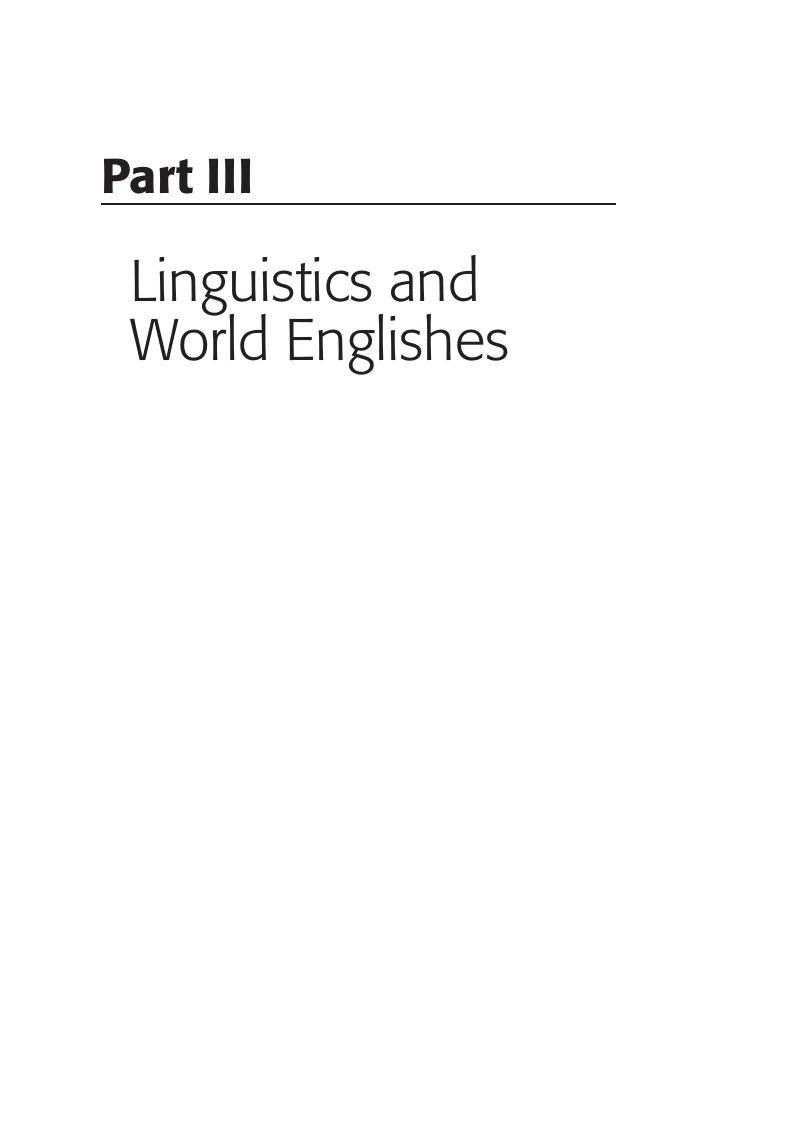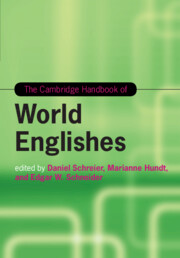Book contents
- The Cambridge Handbook of World Englishes
- Cambridge Handbooks in Language and Linguistics
- The Cambridge Handbook of World Englishes
- Copyright page
- Dedication
- Contents
- Figures
- Maps
- Tables
- Notes on Contributors
- 1 World Englishes: An Introduction
- Part I The Making of Englishes
- Part II World Englishes Old and New
- Part III Linguistics and World Englishes
- Part IV Current Challenges
- Index
- References
Part III - Linguistics and World Englishes
Published online by Cambridge University Press: 16 December 2019
- The Cambridge Handbook of World Englishes
- Cambridge Handbooks in Language and Linguistics
- The Cambridge Handbook of World Englishes
- Copyright page
- Dedication
- Contents
- Figures
- Maps
- Tables
- Notes on Contributors
- 1 World Englishes: An Introduction
- Part I The Making of Englishes
- Part II World Englishes Old and New
- Part III Linguistics and World Englishes
- Part IV Current Challenges
- Index
- References
Summary

- Type
- Chapter
- Information
- The Cambridge Handbook of World Englishes , pp. 309 - 584Publisher: Cambridge University PressPrint publication year: 2020
References
References
References
References
References
References
References
References
Online References
Australian Bureau of Statistics. Cultural Diversity in Australia, 2016. www.abs.gov.au/ausstats/abs@.nsf/Lookup/by%20Subject/2071.0~2016~Main%20Features%7ECultural%20Diversity%20Article~20
British Deaf Association. https://bda.org.uk
The Canadian Association of the Deaf-Association des Sourds du Canada. www.cad.ca
Central Statistics Office – An Phríomh-Oifig Staidrimh www.cso.ie/en/census/census2011reports/census2011thisisirelandpart1/
Deaf Sector Partnership. http://deafsectorpartnership.net/bsl-scotland-act/
Department of Education and Skills. 20-year Strategy for the Irish Language 2010 – 2030. www.education.ie/en/Publications/Policy-Reports/20-Year-Strategy-for-the-Irish-Language-2010–2030.pdf Accessed 24th June 2018.
Department for Education (2015). Statistics: Schools, pupils and their characteristics: January 2015. www.gov.uk/government/collections/statistics-school-and-pupil-numbers
Department for Education (2015). Statistics: Schools, pupils and their characteristics: January 2017. www.gov.uk/government/statistics/schools-pupils-and-their-characteristics-january-2017 Accessed 1st October 2017
Ethnologue: Languages of the World. www.ethnologue.com
European Commission Eurostat. http://ec.europa.eu/eurostat
Government of Canada. 2016 Annual Report to Parliament on Immigration. www.cic.gc.ca/english/resources/publications/annual-report-2016/index.asp#s4.3
Isle of Man Census Report 2011. www.gov.im/media/207882/census2011reportfinalresized_1_.pdf
The Migration Observatory. www.migrationobservatory.ox.ac.uk
New Zealand Census statistics www.stats.govt.nz/Census/2013-census/profile-and…/quickstats…/languages.aspx
Office for National Statistics. www.ons.gov.uk/
Omniglot www.omniglot.com
Scotland’s Census www.scotlandscensus.gov.uk/
Scottish Government British Sign Language (BSL) National Plan 2017–2023 www.gov.scot/Resource/0052/00526382.pdf
Statistics Canada www12.statcan.gc.ca/census-recensement/2016/dp-pd/hlt-fst/lang/Table.cfm?Lang=E&T=11&Geo=00
Statistics Canada. Linguistic Diversity and Multilingualism in Canadian homes. www12.statcan.gc.ca/census-recensement/2016/as-sa/98–200-x/2016010/98–200-x2016010-eng.cfm
Statistics for Wales – ystadegau ar gyfer cymru. http://gov.wales/docs/statistics/2012/121211sb1182012en.pdf
Stats NZ. 2013 Census Quickstats about culture and identity. www.stats.govt.nz/Census/2013-census/profile-and-summary-reports/quickstats-culture-identity/birthplace.aspx
United States Census Bureau www.census.gov/data/tables/2013/demo/2009–2013-lang-tables.html
References
References
= Australian Corpus of English (Written Australian English, 1986)
= Web-derived 2006 Brown Corpus (Written American English, 2006)
= A Representative Corpus of Historical English Registers [www.helsinki.fi/varieng/CoRD/corpora/ARCHER/updated%20version/background.html#history]
= Before Brown Corpus (Written American English, 1930s)
= Web-derived 2006 LOB Corpus (Written British English, 2006)
= Before LOB Corpus (Written British English, 1930s)
= British National Corpus (Spoken and Written British English, 1991–1994; 2014) [www.natcorp.ox.ac.uk]
= Brown Corpus (Written American English, 1961)
= Corpus of Early New Zealand English (see Hundt 2012)
= Corpus of Late Modern English Texts [www.helsinki.fi/varieng/CoRD/corpora/CLMETEV/index.html]
= Corpus of Historical American English [https://corpus.byu.edu/coha/]
= Corpus of Early Ontario English (see Dollinger 2005)
= Corpus of Oz Early English (see Fritz 2007)
= Corpus of Irish English Correspondence (see McCafferty & Amador-Moreno 2012)
= Freiburg Brown Corpus (Written American English, 1992)
= Freiburg LOB Corpus (Written British English, 1991)
= Corpus of Global Web-based English (web-based corpus of World Englishes, approximately 1.9 million words) [www.english-corpora.org/glowbe/]
= International Corpus of English [www.ice-corpora.uzh.ch]
= International Corpus of Learner English (Corpus of argumentative essays from university learners of English as a foreign language, with various first language backgrounds) [https://uclouvain.be/en/research-institutes/ilc/cecl/icle.html]
= The Kolhapur Corpus of Indian English (Written Indian English, 1978)
= Louvain International Database of Spoken English Interlanguage (Spoken learner interview data, various first languages) [https://uclouvain.be/en/research-institutes/ilc/cecl/lindsei.html]
= London-Oslo-Bergen Corpus (Written British English, 1961)
= News on the Web (web-based monitor corpus of newspaper archives from twenty countries; since 2010) [www.english-corpora.org/now/]
= Strathy Corpus of Canadian English (spoken and written Canadian English, 50 million words; data from the early 1980s until 2010; available at BYU) [www.queensu.ca/strathy/corpus]
= Wellington Corpus of Written New Zealand English (Written New Zealand English, 1986)



